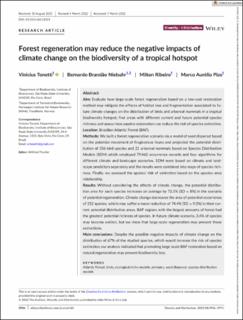| dc.contributor.author | Tonetti, Vinicius | |
| dc.contributor.author | Brandão Niebuhr, Bernardo | |
| dc.contributor.author | Ribeiro, Milton Cezar | |
| dc.contributor.author | Pizo, Marco Aurelio | |
| dc.coverage.spatial | Brasil, Brazil, Brazilian Atlantic Forest | en_US |
| dc.date.accessioned | 2023-01-25T08:31:12Z | |
| dc.date.available | 2023-01-25T08:31:12Z | |
| dc.date.created | 2022-03-22T22:23:38Z | |
| dc.date.issued | 2022 | |
| dc.identifier.citation | Diversity and Distributions: A journal of biological invasions and biodiversity. 2022, 28 2956-2971. | en_US |
| dc.identifier.issn | 1366-9516 | |
| dc.identifier.uri | https://hdl.handle.net/11250/3046067 | |
| dc.description.abstract | Aim Evaluate how large-scale forest regeneration based on a low-cost restoration method may mitigate the effects of habitat loss and fragmentation associated to future climate changes on the distribution of birds and arboreal mammals in a tropical biodiversity hotspot; find areas with different current and future potential species richness and assess how passive restoration can reduce the risk of species extinction. Location Brazilian Atlantic Forest (BAF). Methods We built a forest regeneration scenario via a model of seed dispersal based on the potential movement of frugivorous fauna and projected the potential distribution of 356 bird species and 21 arboreal mammals based on Species Distribution Models (SDM) which employed 79,462 occurrence records and four algorithms for different climate and landscape scenarios. SDM were based on climate and landscape predictors separately and the results were combined into maps of species richness. Finally, we assessed the species’ risk of extinction based on the species–area relationship. Results Without considering the effects of climate change, the potential distribution area for each species increases on average by 72.5% (SD = 8%) in the scenario of potential regeneration. Climate change decreases the area of potential occurrence of 252 species, which may suffer a mean reduction of 74.4% (SD = 9.3%) in their current potential distribution areas. BAF regions with the largest amounts of forest had the greatest potential richness of species. In future climate scenario, 3.4% of species may become extinct, but we show that large-scale regeneration may prevent these extinctions. Main conclusions Despite the possible negative impacts of climate change on the distribution of 67% of the studied species, which would increase the risk of species extinction, our analysis indicated that promoting large-scale BAF restoration based on natural regeneration may prevent biodiversity loss. | en_US |
| dc.language.iso | eng | en_US |
| dc.relation.uri | https://onlinelibrary.wiley.com/doi/full/10.1111/ddi.13523 | |
| dc.rights | Navngivelse 4.0 Internasjonal | * |
| dc.rights.uri | http://creativecommons.org/licenses/by/4.0/deed.no | * |
| dc.subject | Atlantic Forest | en_US |
| dc.subject | birds | en_US |
| dc.subject | ecological niche models | en_US |
| dc.subject | primates | en_US |
| dc.subject | seed dispersal | en_US |
| dc.subject | species distribution models | en_US |
| dc.title | Forest regeneration may reduce the negative impacts of climate change on the biodiversity of a tropical hotspot | en_US |
| dc.title.alternative | Forest regeneration may reduce the negative impacts of climate change on the biodiversity of a tropical hotspot | en_US |
| dc.type | Peer reviewed | en_US |
| dc.type | Journal article | en_US |
| dc.description.version | publishedVersion | en_US |
| dc.rights.holder | © 2022 The Authors | en_US |
| dc.subject.nsi | VDP::Zoologiske og botaniske fag: 480 | en_US |
| dc.subject.nsi | VDP::Zoology and botany: 480 | en_US |
| dc.source.pagenumber | 2956-2971 | en_US |
| dc.source.volume | 28 | en_US |
| dc.source.journal | Diversity and Distributions: A journal of biological invasions and biodiversity | en_US |
| dc.identifier.doi | 10.1111/ddi.13523 | |
| dc.identifier.cristin | 2011825 | |
| dc.relation.project | Norges forskningsråd: 287925 | en_US |
| cristin.ispublished | true | |
| cristin.fulltext | original | |
| cristin.qualitycode | 2 | |

